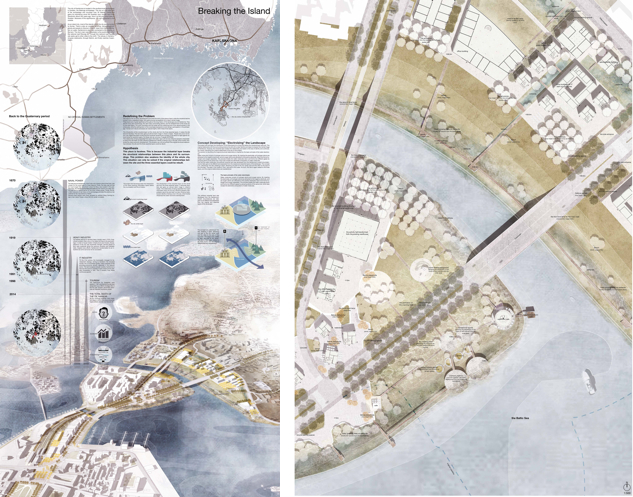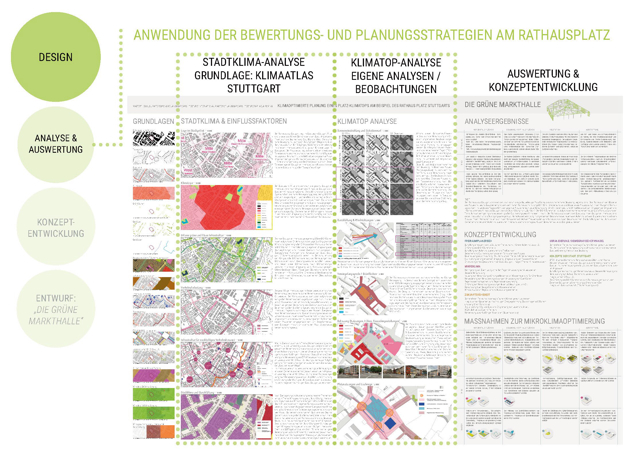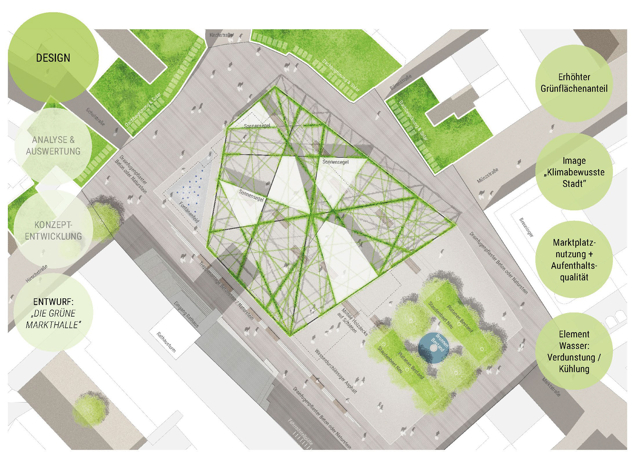Awarded Bachelor and Master Theses 2020

© Xiaozhen Li
BREAKING THE ISLAND.
Application of structuralism to the example of the former oil port in Karlskrona, Sweden.
Author: Xiaozhen Li
Master thesis at the Chair of Landscape Architecture and Industrial Landscape - Technical University of Munich
Supervisor: Prof. Dr. Udo Weilacher, Second examiner: Dipl.-Ing. Jonas Bellingrodt
Abstract
BREAKING THE ISLAND deals with the redevelopment of a disused oil port in Karlskrona, Sweden. Spread over more than 30 islands in the Baltic Sea, the city began large-scale land reclamation in the early 20th century. At that time, the sea bay between the mainland and the main island was filled in for the construction of the oil port. Today, after the industrial downturn, the project area is a faceless wasteland and, as the main entrance to the city center, weakens Karlskrona's identity as a city by the sea. This further weakens social and economic development. In addition, the reclaimed land poses a threat to terrestrial and marine ecosystems due to heavy contamination.
Based on the structuralism theory, BREAKING THE ISLAND analyses the landscape around Karlskrona in three layers of information: the soil morphology, the settlement area and the hydrological layer of the sea. The industrial layer as the fourth layer interrupts the original relationships and thus weakens the identity of the city. In the design, the area is therefore divided into three parts by restoring original water passages, but without negating the industrial past. Each part thus recovers its characteristic qualities, and restores the original structural relationships. This strategy also helps to create a clear spatial access to the city and emphasizes the quality of the area as a city center. The design also strengthens the ecological resilience of the site by allowing space for new marine wetlands to develop along the shoreline. The remaining industrial site will become a Creative Cultural Park for IT companies, driving the transformation of the city from an industrial city to a knowledge city.
Justification of the award
Xiaozhen Li succeeds in an exemplary way in critically addressing current problems, such as rising sea levels in times of climate change, and their effects on port cities like Karlskrona. In addition, the student also addresses problems such as the structural change of industrial cities in her comprehensive, scientifically based explanatory report. On the basis of a thorough and extensive analysis, she uncovers structuralist levels of information on a local, urban and geomorphological level and from this develops an exemplary and sustainable solution for comparable port cities.
The design is presented in excellently elaborated plans and models and convinces through its sensitive handling of structure-giving landscape elements, their supplementation and further development. The student develops a coherent basic concept for the sustainable enhancement of marine ecosystems in the context of a densely populated port city. BREAKING THE ISLAND is thus a promising approach to site-specific and identity-creating urban development in times of climate change and offers trend-setting impulses for dealing with petrochemical relics in the sensitive context of aquatic systems.
With her outstanding Master's thesis, Xiaozhen Li proves her ability to design professionally in the context of complex problems in landscape architecture - not only nationally, but also internationally.

© Sarah Jankowski
SARAJEVO - THE CITY AS CAMPUS
University locations as impulses for sustainable urban development.
Author: Sarah Maria Jankowski
Masterthesis IMLA (International Master of Landscape Architecture) - Weihenstephan-Triesdorf University of Applied Sciences
Supervisors: Prof. Ingrid Schegk, Prof. Christoph Jensen
Abstract
The master thesis 'Sarajevo - The City as Campus' deals with the University of Sarajevo and its integration into the Bosnian capital. The main campus of the University is located in the city centre of Sarajevo in the district of Marijin Dvor and is a relic of a former military installation of the Austro-Hungarian monarchy from the year 1897. This main campus of the University is characterized by barracks, most of which were destroyed during the Bosnian war (1992 - 1995) and are still in this condition. These desolate areas of the campus are currently not usable for university purposes. Efforts are being made to redesign or reorganize the campus in the near future, but there is no concrete prospect of this happening yet. Space is needed for additional faculties, whose locations are currently scattered throughout the city of Sarajevo. A connection of these faculties to the University of Sarajevo is not yet discernible, there is a lack of obvious connections or a network between faculties and the university. In addition, there is no synergistic relationship between the university and the city of Sarajevo, although there is a desire to be perceived as an internationally respected place of study.
Therefore, the aim of the master thesis was to develop proposed solutions for this situation. An environment for successful learning within the city of Sarajevo was to be created from the campus in the core and the most significant secondary centres of the university. The role that the university could play for the city of Sarajevo and the importance of the city's influence on this educational centre were also considered. The development of the concept was based on in-depth research and analysis of the context. On this basis, the following planning and design ideas were developed.
Justification for the award
The work, which makes a contribution to the often underestimated field of design research ('Research by Design'), succeeds in demonstrating the potential of student life for sustainable urban development. Skilful identification, networking and upgrading of open spaces creates a completely new perspective of an attractive city by the river, which can be experienced on foot and by bicycle and which puts the qualities of this very special capital city in perspective. On the basis of an extremely thorough on-site analysis that takes into account urban planning potential as well as social spaces and the needs of the people, the author creates green infrastructures that are convincing in their appropriateness without massive interventions in the urban structure.
The overall concept, the "city as campus", is achieved with a certain nonchalance that is also convincing in terms of presentation. In the detailing of three characteristic example situations, an appropriate design language is chosen. The upgrades, above all of a functional nature, are achieved quite predominantly with comparatively simple means. The work, which deliberately refrains from spectacular interventions, thus does great justice to the city of Sarajevo and the everyday lives of students and residents alike.

© Raphaela Roming
CLIMATE RESPONSIVE DESIGN - Climate-Smart Landscape Architecture.
Development of planning strategies for climate-optimized design of open spaces.
Author: Raphaela Roming
Masterthesis IMLA (International Master of Landscape Architecture) - Weihenstephan-Triesdorf University of Applied Sciences
Supervisor: Prof. Ingrid Schegk, First examiner (HSWT), Second examiner: Prof. Dr. Hendrik Laue (TH Ostwestfalen-Lippe).
Abstract
Climate-appropriate, -adapted, -resilient, or -optimized landscape architecture, different terms describing a significant goal of future landscape architecture as a spatial design discipline: The appropriate response to climate change and its consequences. In this thesis, we will show which developments and changes in our cities are to be expected for the society living in them and which potentials landscape architecture offers to optimize cities in a sustainable way.
Structures, concepts and developments in the locally climatically special situation of Stuttgart, the capital of Baden-Württemberg, are analysed and a specially developed assessment method for the local climate and local climate effects is presented. Principles for climate-appropriate planning of open spaces in general are translated into easily applicable "building blocks of climate-appropriate landscape architecture", presented, explained and applied to the Rathausplatz Stuttgart as a "Kleinklimatop Platz" on a test basis. Based on a detailed analysis of the most important influencing factors and challenges at the site, a comprehensive development concept for the square is developed, supported by the guiding idea of the "green market hall". The central market place in Stuttgart's city centre will thus become the flagship of a climate-conscious city and create a climate-optimised, multifunctional open space that will also withstand future developments in the city and create great added value for the place and its users.

© Raphaela Roming
Justification for the award
The work spans the arc from scientific elaboration to practical design project in an almost exemplary manner. On the basis of comprehensive source research and theory development on the current topic of climate change and its effects in the city, the author succeeds in structuring and translating the complex research results into clear climate building blocks, which she finally tests through practical application in planning and design. It becomes clear that the consideration of conclusive principles can improve the quality of the inner-city microclimate in many cases and thus also make contributions to the overall climatic situation. However, the complexity of climate effects also becomes clear.
The high degree of systematicity and the graphical presentation of the work appear particularly convincing. The results can be transferred very well to other projects and thus represent both a technically sound working and argumentation aid as well as a creative source of inspiration for climate-friendly design.

© Lena Bonengel
Baubotanik Residential Building - A Lifetime Project
Author: Lena Bonengel
Master's thesis at the Chair of Green Technologies in Landscape Architecture at the Technical University of Munich
Supervisor: Prof. Dr. Ferdinand Ludwig
Abstract
Construction botanical projects are - like any tree planting in landscape architecture - projects that require great foresight. It often takes more than one generation until a tree or a tree-botanical structure has developed to its full size and functionality. In her Master's thesis, Lena Bonengel takes on this task in a very personal way. She designs a development concept for her own baubotanic dwelling. In an in-depth analysis phase, she first examines 60 comparable approaches in which a person or a group of people have committed themselves to being responsible for the maintenance and development of a project for a lifetime. Building on this, she consistently relates her own life to her planned construction botanical project. In doing so, she not only makes predictions about the development of the baubotanic structures, but also creates scenarios for her own life. With the help of the online tool "the death clock" she calculates a fictitious date of death for herself (22.02.2096), visualizes her hypothetical aging and relates it visually to the development of the baubotanic structures (Fig. 1).
This almost merciless inclusion of one's own person enables a perspective thinking that points far beyond one's own lifetime. For the story of Lena Bonengel's project does not end with her death. Rather, she continues to tell it for her (fictitious) children and grandchildren and speculates on the transformative power her work could unfold in the distant future. In the process, she takes an astonishingly pragmatic approach to the details and does not lose sight of classic landscape architectural core competencies, such as the choice of suitable tree species. She meticulously runs through various possible development scenarios over a period of 200 years (!). In this way, she combines a radical visionary approach with basic knowledge from her field of study.
At the end, she presented her work in a convincing lecture and on the basis of a model which, with the help of elaborately crafted wire structures, shows a possible state of the trees in approx. 200 years, as well as options for future architectural elements on the basis of 3D-printed components and holographic projections. Atmospheric moods and references to possible technological developments are depicted in the skilfully crafted collages.
Justification for the awardThe work is convincing due to its visionary power and the consistent, fearless conceptual and aesthetic elaboration. Lena Bonengel has succeeded in bringing a speculative approach to the point in a captivatingly clear manner. An approach we see far too rarely in landscape architecture today, and one that should make us think about how we might rethink the future of our planet as well as the role of our profession.
The bdla Young Architects Award is endowed with €250 each and a certificate.
This year's awards are kindly supported by the offices of WGF Consulting and psu - Prof. Schaller UmweltConsult.
- Latitude: 0
- Longitude: 0




